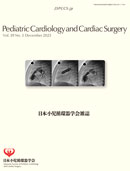Volume 39, Issue 3
Displaying 1-7 of 7 articles from this issue
- |<
- <
- 1
- >
- >|
Preface
-
2023Volume 39Issue 3 Pages 115
Published: December 01, 2023
Released on J-STAGE: June 30, 2024
Download PDF (126K)
Review
-
2023Volume 39Issue 3 Pages 116-125
Published: December 01, 2023
Released on J-STAGE: June 30, 2024
Download PDF (4736K) -
2023Volume 39Issue 3 Pages 126-131
Published: December 01, 2023
Released on J-STAGE: June 30, 2024
Download PDF (2111K) -
2023Volume 39Issue 3 Pages 132-143
Published: December 01, 2023
Released on J-STAGE: June 30, 2024
Download PDF (8885K) -
2023Volume 39Issue 3 Pages 144-152
Published: December 01, 2023
Released on J-STAGE: June 30, 2024
Download PDF (5549K) -
2023Volume 39Issue 3 Pages 153-160
Published: December 01, 2023
Released on J-STAGE: June 30, 2024
Download PDF (5511K) -
2023Volume 39Issue 3 Pages 161-168
Published: December 01, 2023
Released on J-STAGE: June 30, 2024
Download PDF (2213K)
- |<
- <
- 1
- >
- >|
